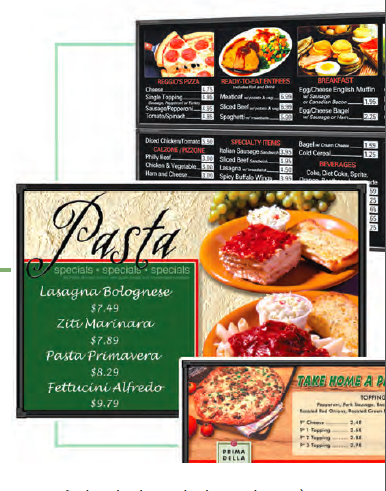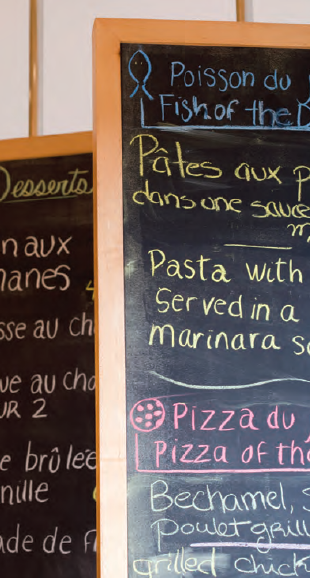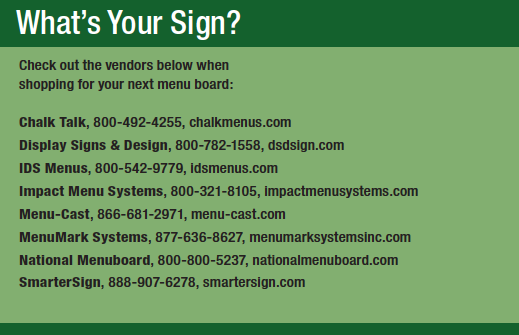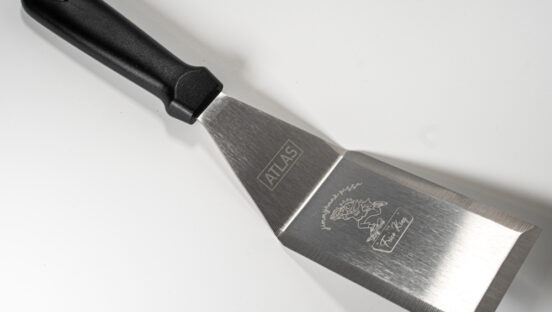 Your menu board hangs there obediently—and usually passively—telling your customers what your staff can cook, and how much money to have at the ready for the purchase. But how can it best serve you? You may already wonder if your customers are engaged with your menu offerings, or if you’re making the most from every order. Your menu board can be a crucial factor in the answer to these questions. Maybe you never think about your menu board; you may think it’s fine the way it is. But if your customers are taking a little longer to order than usual or can’t easily locate high-margin items on your menu, you may want to think about the way in which your menu is presented. But whom do you ask when it’s time to make that upgrade you know you need?
Your menu board hangs there obediently—and usually passively—telling your customers what your staff can cook, and how much money to have at the ready for the purchase. But how can it best serve you? You may already wonder if your customers are engaged with your menu offerings, or if you’re making the most from every order. Your menu board can be a crucial factor in the answer to these questions. Maybe you never think about your menu board; you may think it’s fine the way it is. But if your customers are taking a little longer to order than usual or can’t easily locate high-margin items on your menu, you may want to think about the way in which your menu is presented. But whom do you ask when it’s time to make that upgrade you know you need?
We spoke with several leaders in today’s menu board industry, both electronic and traditional, to find out.
The Traditional Route
Lee Packer, graphic designer at Almena, Wisconsin-based Menu-Mark Systems, says that some operators prefer indoor illuminated menu boards, which are available in multiple sizes and can be mounted next to each other to give the appearance of being a single unit. Meanwhile, indoor non-illuminated magnetic menu boards are also popular. In either case, Packer recommends looking for a company that uses high-impact printing and laminated graphics, and a wide range of frame options.
Michael Wilkinson, director of development for Pete’s New Haven Style Apizza (petesapizza.com), says, “We have two locations in Washington, D.C., and we use traditional menu boards in each. In one of the locations, there are two: One is a large single preprinted panel board with food choices, and the other uses a whiteboard-type material (we write our oft-changing beer selection on that one). Both of those boards hang above the registers and do a good job of helping our customers navigate our menu.”
Chris Cluff, vice president of business development for Duffy’s Tavern & Grill (duffyskennebunk.com) in Kennebunk, Maine, is very pleased with his menu board choices. Cluff says, “We purchased two signs: One is a large specials board, and the other is an A-frame sign for out front.” Cluff says that he spends a lot of time working on the business’ specials, which the new menu boards help communicate directly to their customers.

Russ Fragala, COO of Holbrook, New York-based IDS Menus, says that static menu boards are still widely used and offer affordability for a pizzeria. He posits that signs made of stainless steel, with high-quality graphics, can last through many different menu updates, and electrical or software failure is never a concern.
Matthew Palmer, regional manager of The Pie Pizzeria (thepie.com), with fi ve locations in the Salt Lake City area, says he uses traditional menu boards because they better fit the pizzerias’ atmosphere. “We’re still an old-school pizzeria,” he says. “We try to keep menu adjustments down to no more than once a year, and we seldom change menu items.” If, like Palmer, you rarely change your menu, a traditional menu board may be your best option.
However, “traditional” doesn’t have to mean “boring.” Some operators have found that an artistic touch can increase a menu board’s appeal. Joseph Gallina, vice president of Atlanta-based Pizzeria Venti (pizzeriaventi.com), says that all of the company’s menu boards are made by Chicago artist Joseph Gagnepain and help to bring a little extra character to each location. While each menu board is an individual work of art, it will also accept industry-standard slide-ins for when the menu needs to be updated.
Going Digital
Some experts advocate going the futuristic route. Gregg Zinn from New York based SmarterSign says that digital menu boards have a very shallow learning curve and can be updated from anywhere there is a computer, so you can add or delete items based on availability even if you’re not at the shop.
Diane Davis Barrentine, owner of six Domino’s Pizza (dominos.com) locations in North Mississippi, states that she is changing her stores over to electronic menu boards because of the convenience of updating menu items and prices for all locations via her computer. While Barrentine feels that going digital is the wave of the future, she recognizes that customers also appreciate the printed menus she keeps on the counter; these help keep selection simple for customers who may be distracted by all of the choices available on the screen of the menu board. Barrentine adds that her displays can also be tuned to current events, such as playoff games, breaking news and weather, or any other event deemed to be important to her customers.
Rich Weisman, sales manager at Display Signs & Design in Chicago, points out another alternative to traditional-sized signs and menu boards: custom-built-and-sized LED screens. This allows an operator to request any size or specification, so you need not be limited by unusual spaces. Weisman says that the visual rendering of pictures in LED is so close to lifelike that they help to sell menu items through visuals; and, like any digital signage, these screens also allow for maximum flexibility.
Whether you stay traditional or go digital, the more informative your menu board can be, the greater the chance that your customers will remain satisfied. After all, your menu board offers an opportunity for you to interact with your customers, so present them with enough information to make an informed decision. After all, letting your customers know what you have to offer in the most appealing way possible will go a long way toward your growth.













